The use of digital media in Canada has grown significantly over the past decade and access to news, entertainment, and popular culture from different countries is only a click away. But many Canadians continue to subscribe to traditional media sources for their news. APF Canada’s 2020 National Opinion Poll (NOP) found that most Canadians are still dependent on traditional news sources such as television, radio, and newspapers as their primary sources of information about Asia. Although digital media – including news websites, social media, and weblogs, among others – challenges the power of traditional media formats as the gatekeepers of information, traditional outlets remain a central source of information for many Canadians.
Regardless of this reliance on ‘old school’ forms of news, data from APF Canada’s 2020 National Opinion Poll shows that only 38 per cent of Canadians believe that the Canadian news media provide adequate coverage of issues and developments in Asia. While low, this is an improvement from 2008, when we found that only 27 per cent agreed that news media provided adequate information about issues and developments in Asia. Still, this continuing trend, spanning a decade, demands a closer look at Canadians perceptions of Canadian media. The prominence of news media – both traditional and online – as a source of information coupled with Canadian opinions about its lack of adequacy underscores the importance of content diversity in Canadian news media – particularly when considering the high proportion of “don’t know” responses when Canadians are asked to reflect on how media impacts their perception of certain Asian economies.
Perception of Canadian media adequacy
In APF Canada’s 2020 NOP, older respondents agree more than young and middle-aged respondents that Canadian news media provides adequate information about Asia (see Figure 1). While the 55 years and above age group’s opinion is split, the younger age groups are more resolute in their position. More than half of the respondents between the ages of 18 and 54 years disagree that the Canadian news media provides adequate coverage of issues and developments in Asia.
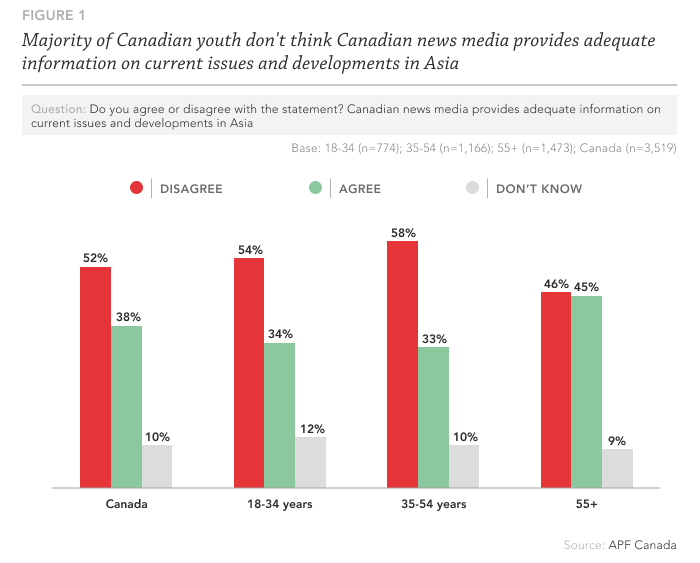
We also found that disagreement that the Canadian media coverage of Asia is adequate grows with the level of education (see Figure 2). The education breakdown reveals that respondents with some post-secondary education or more share a similar opinion, with more than half disagreeing that the Canadian news media coverage of Asia is adequate and about 37 per cent agreeing. Those with a high-school degree or less are more divided, with 41 per cent agreeing that the coverage is adequate and 45 per cent disagreeing.
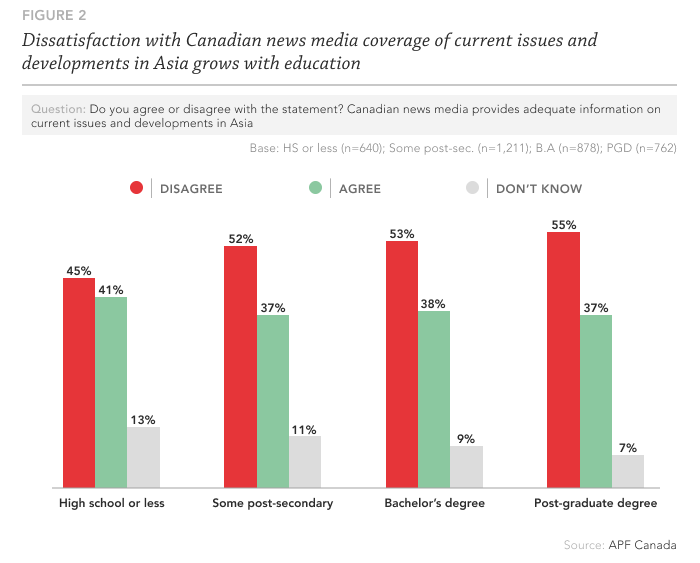
Impact of Canadian media on perception of Asian jurisdictions
Our 2020 National Opinion Poll further asked respondents whether the Canadian media has a positive or negative impact on their perception of eight Asian economies with whom Canada’s relations are growing.
While Canadian media encompasses everything from news media and social media to entertainment programs and popular culture, we found that it generally has a more positive than negative impact on Canadians’ perception of Asian economies. For example, 60 per cent of Canadians said Canadian media has a positive impact on their perception of Japan and 55 per cent said the same for South Korea. For all countries there are more respondents who feel media has a positive impact, rather than a negative impact, on their perception of Asian jurisdictions, except for China, where 66 per cent of respondents said that the media has a negative impact on their perception of China.
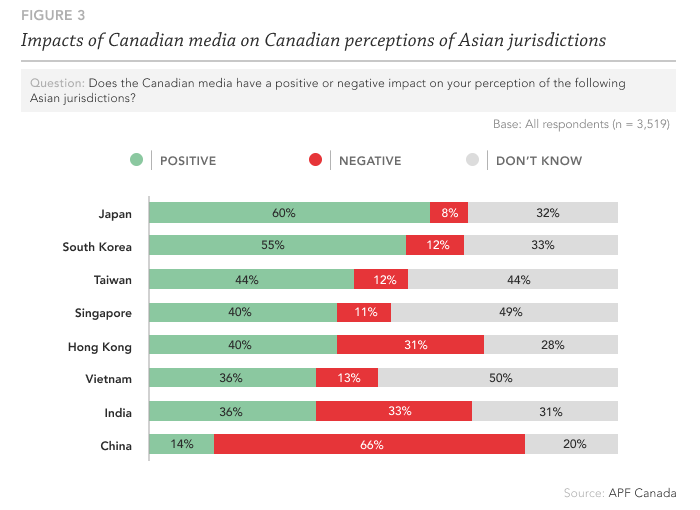
Interestingly, respondents who believe the news media adequately covers Asian affairs generally find Canadian media to positively impact their perceptions of Asian jurisdictions more so than those who disagree that Canadian news media is adequate, and vice-versa. It is possible that respondents who feel Canadian news media coverage of Asian issues is inadequate also feel that there is an excess of negative or incomplete coverage. Therefore, they believe that media has a negative impact on their perceptions of Asian economies. There may be other factors that this poll did not measure, which affect this observed relationship between the perception of media adequacy and the perceived impact of media on perceptions of Asian countries.
Another noteworthy observation is the relation between education and the impact of media on perceptions of Asian economies (see Figure 4). Respondents with a bachelor’s degree or more see a more positive impact of media on their perceptions of most Asian jurisdictions compared to respondents with less than a bachelor’s degree. The average opinion on the question significantly differs between these education groups for Japan, South Korea, Taiwan, Singapore, and Vietnam. For China, there is no significant difference between the education groups.
Essentially, respondents with higher education levels are more critical of Canadian news media content (as seen in Figure 2), but for certain Asian economies they find that media had positive implications on their perceptions more so than other respondents. This could be related to positive coverage of those economies, but not necessarily seen as adequate coverage.

Similarly, older respondents see a more positive impact of Canadian media on their perception for all Asian jurisdictions – except for China – and to a greater extent for Japan and South Korea (see Figure 5).
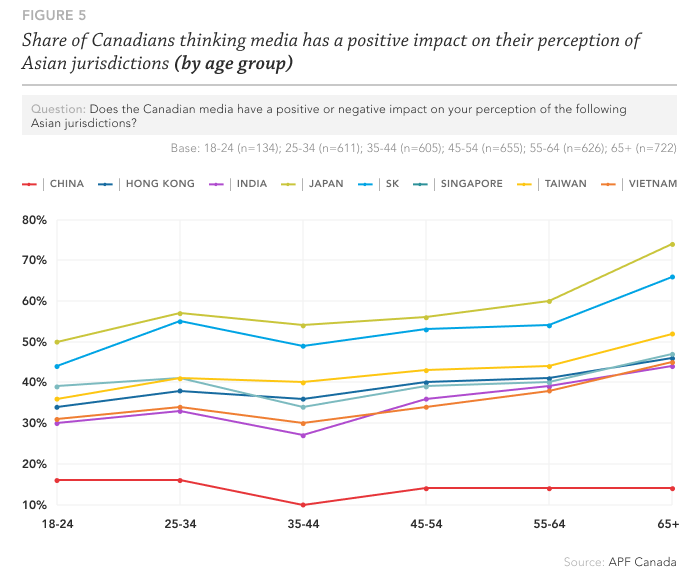
The more educated or older the respondents are, the less likely they are to perceive media as having a positive impact on their perception of China. But for almost all other Asian economies, the view that media has a positive impact on perceptions grow with education or age.
Previous research suggests that there is a correlation between public opinion and the media framing of Asian economies, despite variations in the quantity of media reports for each economy. However, further research on Canadian media adequacy and effects could help reveal how media framing and agenda-setting play a role on public perceptions of different Asian economies and further help us understand how media can shape public opinion.
Sources of information about Asia
In 2019, 98 per cent of Canadians’ consumed internet-based media on a weekly basis, which is a substantial increase from 77 per cent in 2012. The weekly reach of TV and radio remained steady for the most part of the last decade, but newspaper and magazine consumption rates declined severely. APF Canada’s 2020 NOP also polled Canadians on their top-three sources of information about Asia/Asians. Overall, the top sources of information were identified as traditional news sources (78%), news from online or social media sources (55%), conversations with family, friends, and colleagues in Canada/Asia (36%), and education (25%).
The top sources of information about Asia consulted by Canadians vary by age (Figure 6). The most common source of information for respondents in the 18-to-24 age group is news from online or social media, while it is traditional news sources for all other age groups. Education also plays a more important role in informing younger Canadians about Asia, while conversations seem to play a slightly more important role for all other age groups. Similarly, the importance of popular culture (e.g. music, movies, fashion, and video games) as a source of information about Asia declines with age. It is gradually outranked by hands-on experiences (e.g. work, travel, and life experiences), literature and art about/from Asia (e.g. books, artworks), and entertainment programs (e.g. talk show, drama, and reality shows).
Overall, the top sources of information about Asia/Asians for younger respondents are more diverse than for older respondents, who rely heavily on traditional news sources. We also found that respondents with a post-secondary education or less rely more on online or social media, popular culture, or entertainment programs to get information about Asia and Asians, than respondents with a bachelor’s degree or more.

Exploring the “don’t know” responses
As is often the case with questions about specific Asian economies, many Canadians answered with “don’t know” when expressing their views about Canadian media’s impact on their perception of Asian economies such as Vietnam (50%), Singapore (49%), and Taiwan (44%). For the remaining countries, the “don’t know” response rates are closer to 30 per cent. The high “don’t know” response rates can likely be attributed to either low awareness, low media coverage, or respondents’ ambivalence about the matter.
For both questions – the adequacy of news media and the impact of Canadian media – the highest proportion of “don’t know” responses came from younger age groups and females. On the impact of Canadian media, the “don’t know” response rate is about 25 per cent higher for females than males for all countries (see Table 1). In terms of age, the “don’t know” response rate is much higher for those aged 18-to-54 than respondents aged 55 years or more – with the exception of Singapore, Vietnam, and Taiwan, for which the average “don’t know” response rate is much higher.
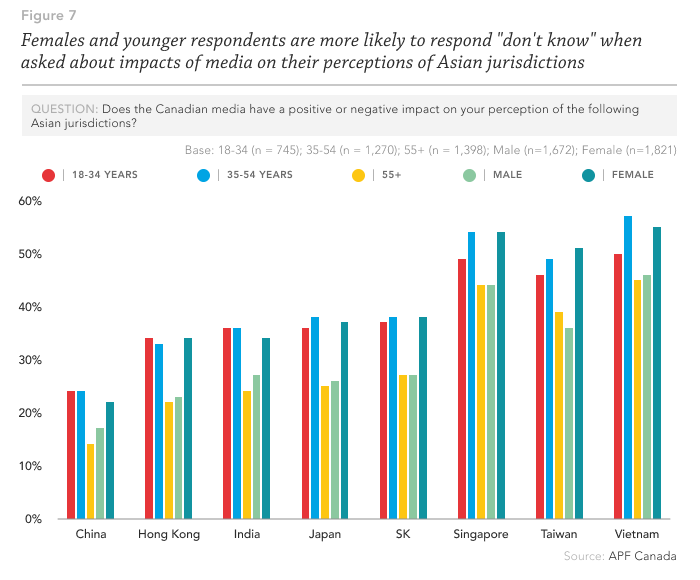
We also observed that respondents who chose traditional news media among their top-three sources of information were less likely to say “don’t know” about media impacts on their perception of China, Hong Kong, India, Japan, and South Korea. This was not the case for Singapore, Taiwan, and Vietnam, which arguably receive less coverage in traditional news sources. Furthermore, respondents who chose education among their top sources of information also recorded a lower rate of “don’t know” for all Asian jurisdictions.
Future of Canadian media
The APF Canada 2020 National Opinion Poll indicates that Canadians from all age and education groups continue to rely on traditional news sources as a top source of information about Asia or Asians. And yet, less than four out of 10 respondents find that Canadian news media provides adequate information about Asia.
Respondents with a higher level of education, and similarly older respondents, believe that Canadian media has a more positive impact on their perceptions of most Asian jurisdictions, and they also identify traditional news sources among their top-three sources of information about Asia more often than other groups. But the more educated the respondents are or the younger the respondents are, the more critical they are about Canadian news media adequacy on coverage of Asian issues and developments.
The importance of diversifying news coverage and bringing in more analysis around Asian countries and issues is further highlighted by the high proportion of Canadians who express no opinions, particularly when asked about smaller economies such as Singapore, Taiwan, and Vietnam. Coupled with education, Canadian media can play a significant role in building more awareness and competency about Asia and Asians in order to better prepare Canadians for a changing global economy.



